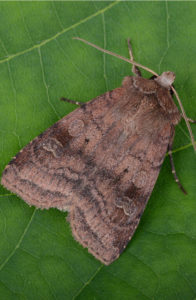Moving into issues that may occur on your lawn, this week we will be focusing on worms: Cutworms and Sod Web Worms.
Cutworms, common name for the caterpillar or adult of certain moths in the family that includes the armyworms, loopers, underwings and many others. Cutworms can impact and affect the health of a variety of plants, especially during the seedling stage. They are known to consume roots, shoots, stems, buds and young leaves. In heavy infestations, young plants may appear to have been cut off at the ground by the caterpillars’ feeding, which is where they got the name cutworms. They are also nocturnal, sometimes climbing fruit trees to reach the leaves and buds, and they like to hide under vegetation, stones or burrow into the ground during the daytime. They have the common appearance of a caterpillar, mostly smooth-bodied and dull-colored, and as an adult moth, they are recognized by their stout-bodies and have dull, gray or brown mottled wings.

Sod webworms are also caterpillars of a brown or dull gray moth. Webworms grow to a length of nearly ¾” and vary in color from pinkish white to yellowish brown with a light to dark brown or black head. They are covered with fine hairs and the adult moths have a wingspan of about ¾”. They fold their wings closely about their bodies when at rest and have a prominent forward projection on the head. Moths hide in shrubbery or other sheltered spots during the day. They are noticeable in the early evening, as they fly over and around the lawn. The female moth scatters her eggs over the lawn as she flies, which is how they spread. Sod webworms feed only at night and you can see the damage on the grass blades that have the appearance of notches on the sides and chewed raggedly. Irregular brown spots are the first signs of damage, and if left untreated, larger areas of grass can and will be more severe in the damage caused by these worms. A heavy infestation, if again, left untreated, can destroy a lawn in just a few short days.
